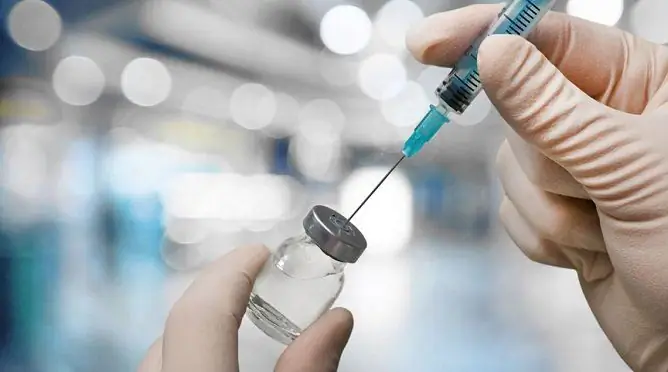- Author Rachel Wainwright [email protected].
- Public 2023-12-15 07:39.
- Last modified 2025-11-02 20:14.
Prevenar
Prevenar: instructions for use and reviews
- 1. Release form and composition
- 2. Pharmacological properties
- 3. Indications for use
- 4. Contraindications
- 5. Method of application and dosage
- 6. Side effects
- 7. Overdose
- 8. Special instructions
- 9. Use in childhood
- 10. Drug interactions
- 11. Analogs
- 12. Terms and conditions of storage
- 13. Terms of dispensing from pharmacies
- 14. Reviews
- 15. Price in pharmacies
Latin name: Prevenar
ATX code: J07AL02
Active ingredient: pneumococcal polysaccharide conjugate adsorbed vaccine (pneumococcal polysaccharide conjugate vaccine absorbed)
Producer: Wyeth Pharmaceutical Division of Wyeth Holdings Corporation (USA), Pfizer Ireland Pharmaceuticals (Ireland), Baxter Pharmaceutical Solutions, LLC (USA), NPO Petrovax Pharm, LLC (Russia)
Description and photo update: 2018-26-10
Prices in pharmacies: from 1799 rubles.
Buy

Prevenar (pneumococcal polysaccharide conjugate adsorbed vaccine) is a drug with an immunomodulatory effect.
Release form and composition
The dosage form of Prevenar is a suspension for intramuscular administration: white, homogeneous, the presence of a cloudy white precipitate is permissible (in disposable syringes made of colorless glass, 0.5 ml each, in a cardboard box 2 plastic packs of 5 syringes, complete with 10 injection needles or 1 plastic package of 1 syringe complete with 1 injection needle).
The active substance in the composition of 0.5 mg (1 dose) is pneumococcal conjugates (polysaccharide + CRM197), including:
- polysaccharide serotype 4 - 0.002 mg;
- polysaccharide serotype 6B - 0.004 mg;
- polysaccharide serotype 9V - 0.002 mg;
- polysaccharide serotype 14 - 0.002 mg;
- oligosaccharide serotype 18C - 0.002 mg;
- polysaccharide serotype 19F - 0.002 mg;
- polysaccharide serotype 23F - 0.002 mg.
Auxiliary components: aluminum phosphate, sodium chloride, water for injection.
Pharmacological properties
Pharmacodynamics
Prevenar is a vaccine for the prevention of pneumococcal infections. It contains 7 active substances - pneumococcal polysaccharides obtained from gram-positive bacteria Streptococcus pneumoniae, individually conjugated with the CRM197 diphtheria carrier protein and adsorbed on aluminum phosphate.
The introduction of Prevenar leads to the development of antibodies to capsular polysaccharides of Streptococcus pneumoniae serotypes 4, 6B, 9V, 14, 18C, 19F, 23F, which provides specific protection of the body against infections caused by bacteria.
When using various vaccination schemes in children of the first year of life, starting from two months of age, after a series of primary vaccinations and a secondary immune response to the last administered dose (i.e., during revaccination), the formation of a protective immune response has been demonstrated. After three doses of the primary vaccination and subsequent revaccination, there is a significant increase in antibody levels. Thanks to Prevenar, the formation of functional antibodies to all vaccine serotypes is induced.
The pronounced formation of antibodies to all serotypes of the vaccine in children 2-5 years old is observed after a single injection of the drug, while the immune response practically coincides with that in children of the first two years of life after a series of primary immunizations.
According to large-scale clinical studies of the effectiveness of immunization, Prevenar has a high specific efficiency for the prevention of invasive pneumococcal diseases (IPPD). The drug is effective in the prevention of pneumonia and acute otitis media (approximately 87.5 and 54%, respectively).
Indications for use
According to the instructions, Prevenar is prescribed to children from 2 months to 5 years old for the prevention of diseases caused by Streptococcus pneumoniae serotypes 4, 6B, 9V, 14, 18C, 19F and 23F, including meningitis, sepsis, pneumonia, acute otitis media and bacteremia.
Contraindications
- acute infectious / non-infectious diseases, exacerbation of chronic diseases (in these cases, vaccination is carried out after recovery or in remission);
- individual intolerance to the components of the drug, as well as hypersensitivity reactions during previous use of Prevenar.
Instructions for use Prevenar: method and dosage
Prevenar vaccine is administered intramuscularly:
- children under 2 years old: in the anterolateral surface of the thigh;
- children 2 years of age and older: in the deltoid muscle of the shoulder.
Intravenous administration of Prevenar is contraindicated.
Vaccination scheme (single dose - 0.5 ml):
- 2-6 months: 3 doses of vaccine, intervals between doses of at least 30 days; the first dose is usually given at 2 months of age; the optimal time for revaccination (fourth dose) is 12-15 months. If vaccination has not been started during the first half of life, Prevenar should be used according to the schemes below;
- 7-11 months: 2 doses, intervals between doses - at least 30 days; the optimal time for revaccination (third dose) is 12-23 months;
- 12-23 months: 2 doses, intervals between doses - at least 60 days;
- 2-5 years: 1 dose once.
After each of the above immunization regimens, the need for any additional dose has not been established.
Before using Prevenar, the contents of the syringe must be shaken until a homogeneous suspension is obtained. If during examination, foreign particles are detected in the contents of the syringe, or it has changed its physical properties, the drug cannot be used.
Side effects
The most common adverse reactions to vaccinations are fever (fever) and soreness at the injection site.
During revaccination, the following disorders were most often observed: rapidly passing soreness at the injection site, short-term limitation of the range of motion of the limb associated with pain at the injection site.
When receiving a single injection, older children develop local reactions more often than children under 18 months of age, and these disorders are usually of short duration.
During primary vaccination in children under 28 weeks of age, the possible risk of apnea should be taken into account, especially with a history of immaturity of the respiratory system.
Reactogenicity was noted higher in children who received whole-cell pertussis vaccines (DPT) simultaneously with Prevenar. Temperatures above 38 ° С and above were observed in 41.2% of cases, and above 39 ° С - in 3.3% of children (compared with 1.2% of children in whom only CDS was used). A similar increase in the incidence of high fever is observed when combined with hexavalent vaccines used in pediatrics (against diphtheria, poliomyelitis, pertussis, hepatitis B, tetanus, hemophilus influenza type B).
Possible adverse reactions (> 10% - very common;> 1% and 0.1% and 0.01% and <0.1% - rarely; <0.01% - very rare):
- local reactions: very often - redness, pain / soreness, induration / swelling; often - induration / swelling of the injection site and redness more than 24 mm, increased soreness at the injection site, which can cause a short-term limitation of the range of motion of the limb; rarely - allergic reactions at the injection site (in the form of dermatitis, itching, urticaria);
- general reactions: very often - hyperthermia (38 ° C and above), drowsiness, irritability, tearfulness, restless sleep; often - hyperthermia (more than 39 ° C); rarely - hyporeactivity, episodes of arterial hypotension;
- digestive system: very often - diarrhea, vomiting, decreased appetite;
- central nervous system: rarely - convulsions, including febrile;
- allergic and dermatological reactions: sometimes - urticaria; rarely - hypersensitivity reactions, including bronchospasm, angioedema, anaphylactic shock, Quincke's edema, dyspnea; very rarely - erythema multiforme;
- others: very rarely - regional lymphadenopathy.
Overdose
There are reports of several cases of overdose of Prevenar, as well as the introduction of a subsequent dose of the previously prescribed time. The observed adverse reactions did not differ from those when using the drug in the recommended single doses.
special instructions
Prevenar is not given to adults.
Given the likelihood of developing anaphylactic reactions, the child should be under appropriate medical supervision for at least 30 minutes after the vaccine is administered.
During the initial series of vaccinations in children under the age of 28 weeks, due to the potential likelihood of apnea, it is necessary to provide for the possibility of monitoring the patient's condition for 48-72 hours, especially if there is a history of immaturity of the respiratory system. Since the benefits of vaccination in this group of patients are especially high, it is not recommended to refuse vaccination or postpone its timing.
The drug does not protect against Streptococcus pneumoniae serotypes that are not part of Prevenar, as well as against other microorganisms that cause invasive diseases or otitis media.
A variable decrease in response to pertussis antigens, as well as to inactivated poliomyelitis vaccine, has been described.
There is limited information on the combined use of Prevenar with measles, mumps and rubella vaccine, as well as chickenpox vaccine.
Prevenar should not be prescribed to children with thrombocytopenia or other disorders of the blood coagulation system, the presence of which is a contraindication to intramuscular injections. The exceptions are cases when the benefits of the vaccine are assessed higher than the risks associated with the use of the drug.
In case of impaired immunoreactivity due to immunosuppressive therapy for HIV infection or other reasons, in response to vaccination, a decrease in the formation of antibodies is possible.
Limited evidence suggests that the use of Prevenar in infants with sickle cell disease results in a sufficient immune response with a safety profile that does not differ from children not at high risk. Currently, there is no information on the safety / immunogenicity of the vaccine in children from other high-risk groups for invasive pneumococcal diseases (for example, with hereditary / acquired spleen dysfunction, HIV infection, malignant neoplasms, nephrotic syndrome). The decision to vaccinate children from high risk groups is made individually.
Vaccination in children from high-risk groups under the age of 2 years is carried out according to the Prevenar prescription scheme.
In cases where children aged 2 years and older who are at high risk (for example, with asplenia, sickle cell anemia, chronic diseases with immune dysfunction, HIV infection), primarily vaccinated with Prevenar, are shown 23-valent pneumococcal polysaccharide vaccine, it should be given at least 8 weeks apart between vaccinations.
Due to the higher risk of developing febrile reactions, antipyretics are prescribed for prophylactic purposes to all children receiving Prevenar in combination with whole-cell pertussis vaccines, as well as to children with seizure disorders, including those with a history of febrile seizures.
Do not transfer the contents of the syringe to another container and do not mix with other drugs / substances.
Pediatric use
Prevenar is intended for use in children aged 2 months to 5 years.
Drug interactions
According to the prescribed immunization schedule, Prevenar can be used on the same day with other vaccines that are included in the National Preventive Vaccination Schedule (except BCG - Bacillus Calmette - Guerin), as well as with Infanrix hexavalent vaccine and Hib vaccine against hemophilus influenza b. Vaccines should always be administered in different parts of the body.
Analogs
The analogues of Prevenar are: Pnevmo 23, Pnevmovaks 23, Sinflorix, Prevenar 13.
Terms and conditions of storage
Store at 2-8 ° C. Keep out of the reach of children. Do not freeze.
The shelf life is 3 years.
Terms of dispensing from pharmacies
Dispensed by prescription.
Reviews about Prevenar
Reviews about Prevenar are contradictory. Many people note high efficiency and good tolerance. However, there are reports of the development of severe adverse reactions, as well as that the vaccine does not provide 100% protection.
Price for Prevenar in pharmacies
The approximate price for Prevenar, a vaccine for the prevention of pneumococcal inf-th 0.5 ml / 1 dose - from 1850 rubles.
Prevenar: prices in online pharmacies
|
Drug name Price Pharmacy |
|
Prevenar 13 pneumococcal vaccine 0.5 ml / dose suspension for intramuscular administration 0.5 ml 1 pc. 1799 RUB Buy |

Maria Kulkes Medical journalist About the author
Education: First Moscow State Medical University named after I. M. Sechenov, specialty "General Medicine".
Information about the drug is generalized, provided for informational purposes only and does not replace the official instructions. Self-medication is hazardous to health!






